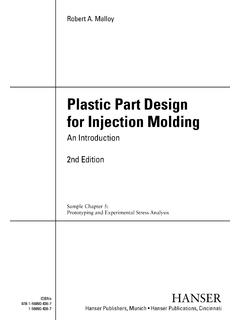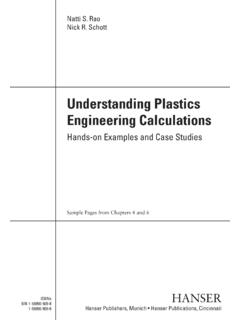Transcription of Troubleshooting the Extrusion Process - Hanser Publications
1 Troubleshooting theExtrusion ProcessA Systematic Approach to SolvingPlastic Extrusion Problems2nd EditionMaria del Pilar Noriega RauwendaalISBNs978-1-56990-470-11-56990- 470-7 HANSERH anser Publishers, Munich Hanser Publications , CincinnatiSample Chapter 1:Requirements for Effi cient Troubleshooting1 Requirements for Efficient TroubleshootingBeforeactingonaspecific Extrusion problem, the troubleshooter should address certainissues. It is important to diagnose a developing extruder problem quickly and accurately tominimize downtime or off-quality instrumentation and a solid understandingof the Extrusion Process are important requirements for efficient Troubleshooting . Instru-mentation is very important in Process control, but absolutely essential in good instrumentation, Troubleshooting is a guessing game at best, even when thetroubleshooter fully understands the entire Process .
2 Thus, lack of instrumentation can provevery costly when it causes a particular problem to remain unsolved for even a limited lengthof prerequisites to an efficient problem solving Process are: Good instrumentation Good understanding of the Extrusion Process Collection and analysis of historical data Team building Good information about the condition of the equipment Good information about the feed Extrusion Process is, to a large extent, a black box Process . It is not possible to coming out of the Extrusion die. However, what happens between the feed openingand the die exit cannot be seen in normal extruders because the Process is obscured by theextruder barrel. Therefore we are largely dependent on instrumentation to determine whathappens inside the can think of instrumentation as our window to the Process .Becauseitisverydifficult to determine what is happening inside the extruder without goodinstrumentation, successful problem solving requires good is not sufficient to have ample instrumentation on the extruder; it is also important toconfirm that the sensors and readouts are working correctly.
3 For instance, if a temperaturezone along the extruder is showing an excessively low or high temperature, we should verifythat the temperature reading is correct. The measuring instruments must be correctly cali-brated, and we should establish that the instrument is capable of measuring the variationof interest. In statistical Process control (SPC), specific procedures have been developed todetermine the capability of the measuring instrument [1].21 RequirementsforEfficient the Extrusion ProcessA good understanding of the Extrusion Process is necessary to solve Extrusion problemsefficiently. It is recommended for the reader new to Extrusion to take classes covering thematerial characteristics of plastics, typical features of Extrusion machinery, instrumentationand operating controls, the inner workings of extruders, and screw and die design.
4 Classesand continuing education short courses on Extrusion are available from a variety of collegesand organizations. There are also a number of training programs available [2] as videos,interactive computer-based instruction, and web-based many Extrusion operations, the primary mode of training is on-the-job training. However,on-the-job training is often the least effective and most expensive method of are expensive machines that must be operated correctly to produce good parts. If anextruder is not operated correctly, out-of-spec parts may be produced, or the extruder maybe damaged. It is also important to realize that extruders are potentially dangerous accidents can occur when extruders are not operating ,it is imper-ative that people who operate Extrusion equipment receive comprehensive safety short review of the Extrusion Process implies the understanding of the functional functional zones of a conventional single screw extruder are shown in.
5 Feed hopper,this zone is designed to operate under gravityflow and it feeds the granulesor the particulate solids into the extruder, solids conveying zone,this zone is designed to transport and to slightly compress the gran-ules or the particulate solids, plasticating zone,polymer melting takes place in this zone due to viscous dissipation andheat transfer by conduction from the extruder barrel, melt conveying zone(ormetering zone), this zone is intended to transport the moltenpolymeric material and to achieve pressure buildup, mixing zone,, this zone is designed to improve melt homogeneity by means of shear mixingelements, such as distributive, dispersive, or elongational mixers, die forming,theformingorshapingoftheextrudat etakesplaceinthiszoneforsubsequentpost-e xtrusion processes, such as calibration, cooling, winding or cutting, among others,and venting,, this zone is only present in two-stage screw extruders or vented extruders and isused to remove any residual moisture or volatiles from the polymer and Analysis of Historical Data (Time Line)To understand why a Process is not behaving correctly, we must compare the current processconditions with previous conditions when the problem did not exist.
6 This is known asconstructing a time line. The data to be collected include not only Process information Collection and Analysis of Historical Data (Time Line)3 TemperatureprofilePressurebuildupMeltSol ids/MeltSolids321 Dieforming4321 DieMelt conveyingand mixing zonePlasticatingzoneSolids conveyingzoneFeed hopperLH5H4H3H2H1 Figure zones in a single screw extruderthe extruder, such as temperatures, pressures, motor load, line speeds, barrel dimensions,screw dimensions, and such, but also information about the material as well as any othervariables that can affect the Process . Changes in the Process can occur not only as a result ofdeviations in machine parameters, but also as a result of material variations. For instance, achange in the stabilizer level of the plastic can cause degradation problems in the absence ofchanges in the machine conditions and settings (Section ).
7 The time line is constructed on the basis of the fact that the Process was running well fora certain period of time. Therefore, there must be an identifiable change or changes thatprecipitated the Process upset. The task is to identify these changes and correct them, andthus get the Process back in control. The time line creation Process starts during a periodof Process stability and ends some time after the problems in the Process were noticed. Allevents even remotely connected to the Process are listed on the time line. Once the time lineis complete, it becomes a helpful tool for identifying the event that precipitated the should be noted that not all events result in an immediate problem. In some cases there canbeaconsiderableincubationtimebeforeth eeffects of a change become noticeable. This, ofcourse, complicates the Troubleshooting Process ; it is important to keep this in mind and notjump to conclusions.
8 The author (CR) experienced a case when a disastrous wear problemwas the result of an event that took place four months wear remained insignificant41 RequirementsforEfficient Troubleshootinguntil approximately four months after a new feed housing was installed. However, once rapidwear commenced, a screw was destroyed within 48 shows an example of a time line leading up to a gel problem. In constructing thetime line, the troubleshooter should be sure to list all events that could potentially affect theprocess. Events such as a power outage, the installation of a new or refurbished extruderscrew, or a new resin lot should obviously be included. Some events (such as constructionin the area, changes in material handling, maintenance on the plant water system, operatortraining, or power surges) are less obvious but may still affect the problem, 6-05-2000 New extruder screw installed 11-28-99 New extruder operator John Haynes, 03-07-00 Resin lot 110199 Resin lot 011200 Replaced die heater and thermocouples, 01-27-00 Resin lot 032300 Resin lot 052400 Replaced brushed on DC motor, 01-22-00 November 1999 December 1999 January 2000 February 2000 March 2000 April 2000 May 2000 June 2000 Replaced oil in gearbox, 02-15-00 Changed barrel temperature profile, 04-12-00 Installed refurbished Extrusion die, 04-23-00 Power outage, 02-26-00 Replaced gearpump, 05-09-00 Miked screw and barrel, 05-29-00 (in spec)
9 Replaced temperature sensor in water line, 03-16-00 Replaced desiccant in dryer, 05-02-00 Figure of a time line leading up to a gel BuildingIf the scope of a problem is small,a single individual can perform the problem solving Process ,and there is no need to organize a team. In many cases, however, problems involve severaldifferent departments and functions and require a wide range of skills for solution. In suchcases, a team effort is needed. Extrusion problems often require input from materials qualitycontrol (QC), purchasing, maintenance, engineering, and possibly from other Condition of the of the EquipmentWhen a problem develops on an extruder, it is important to have good information on thecondition of the equipment. Extruders should be well maintained, and good maintenancerecords should be available to assess the condition of the various components of the recommendations from the extruder manufacturer should be followed to ensuregood screws and barrels will wear over time.
10 The wear rate depends on many screws can last for several years or only several weeks. It is important to measurethe internal diameter (ID) of the barrel and the outer diameter (OD) of the screw on a regularbasis, at least once a year, so that the life of the screw and barrel can be predicted. This allowsthe screw and the barrel to be replaced at predetermined intervals preventing about the Feed StockThe performance of an extruder is determined as much by the characteristics of the feedstock as by the characteristics of the machine. Feed stock properties that affect the extrusionprocess include bulkflow properties, meltflow properties, and thermal properties. Importantbulkflow properties are the bulk density,compressibility,particle size,particle shape,externaland internal coefficients of friction, and agglomeration tendency.









